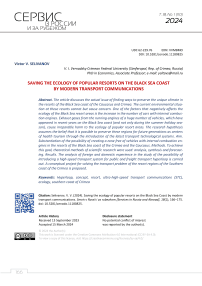Saving the ecology of popular resorts on the Black Sea coast by modern transport communications
Автор: Selivanov V.V.
Журнал: Сервис в России и за рубежом @service-rusjournal
Рубрика: Маркетинг услуг и территорий
Статья в выпуске: 1 (110), 2024 года.
Бесплатный доступ
The article discusses the actual issue of finding ways to preserve the unique climate in the resorts of the Black Sea coast of the Caucasus and Crimea. The current environmental situation at these resorts cannot but cause concern. One of the factors that negatively affects the ecology of the Black Sea resort areas is the increase in the number of cars with internal combustion engines. Exhaust gases from the running engines of a huge number of vehicles, which have appeared in recent years on the Black Sea coast (and not only during the summer holiday season), cause irreparable harm to the ecology of popular resort areas. The research hypothesis assumes the belief that it is possible to preserve these regions for future generations as centers of health tourism through the introduction of the latest transport technological systems.
Hyperloop, concept, resort, ultra-high-speed transport communications (stc), ecology, southern coast of crimea
Короткий адрес: https://sciup.org/140305396
IDR: 140305396 | УДК: 62-229.76 | DOI: 10.5281/zenodo.11180825
Список литературы Saving the ecology of popular resorts on the Black Sea coast by modern transport communications
- Antonov, Yu. F., & Zaitsev, A .A. (2014). Tehnologiya magnitilevitacionnogo transporta [Magnetolevitation transport technology]. Moscow: Fizmatlit. (In Russ.).
- Bertolini, L. (2000). Planning in the borderless city: A conceptualization and an application to the case of station area redevelopment. Town Planning Review, 71, 455-475. doi: 10.3828/tpr.71.4.2883q121q1671185.
- Brotchie, J. (1991). Fast rail networks and socio-economic impacts. Cities of the 21st Century: New Technologies and Spatial Systems. Cheshire: Longman.
- Brunello, L. (2018). High-Speed Rail and Access Transit Networks. Cham: Springer. doi: 10.1007/978-3-319-61415-1.
- Chen, C., Loukaitou-Sideris, A., De Ureña, J., & Vickerman, R. (2019). Spatial short and long-term implications and planning challenges of high-speed rail: A literature review framework for the special issue. European Planning Studies, 27, 415-433. doi: 10.1080/09654313.2018.1562658.
- Cheng, Y. (2010). High-speed rail in Taiwan: New experience and issues for future development. Transport Policy, 17, 51-63. doi: 10.1016/j.tranpol.2009.10.009.
- Flyvbjerg, B. (2012). Why mass media matter to planning research. Journal of Planning Education and Research, 32, 169-181. doi: 10.1177/0739456X12441950.
- Garmendia, M., Ribalaygua, C., & Ureña, J. (2012). High speed rail: implication for cities. Cities, 29, 26-31. doi: 10.1016/j.cities.2012.06.005.
- Janzen, R. (2017). Trans pod ultra-high-speed tube transportation: dynamics of vehicles and infrastructure. Procedia Engineering, 199, 8-17. doi: 10.1016/j.proeng.2017.09.142.
- Kenworthy, J. (2021). Urban structure and its impact on mobility patterns: reducing automobile dependence through polycentrism. In book: The Palgrave Encyclopedia of Urban and Regional Futures. Cham: Palgrave Springer Nature. doi: 10.1007/978-3-030-51812-7_167-1.
- Max, M. J. (2019). How does the aerodynamic design implement in hyperloop concept? Mechanical Engineering. Massachusetts Institute of Technology.
- Moyano, A., Rivas, A., & Coronado, J. (2019). Business and tourism high-speed rail same-day trips: factors influencing the efficiency of high-speed rail links for Spanish cities. European Planning Studies, 27, 533-554. doi: 10.1080/09654313.2018.1562657.
- Nepomnyashchy, N. N. (2012). Zagadki istorii Rossii [Riddles of the history of Russia]. Moscow: Veche. (In Russ.).
- Nikitas, A., Kougias, I., Alyavina, E., & Njoya Tchouamou, E. (2017). How can autonomous and connected vehicles, electromobility, BRT, hyperloop, shared use mobility and mobility as a service shape transport future for the context of smart cities? Urban Science, 36, 40036. doi: 10.3390/urbansci1040036.
- Özbek, R., & Çodur, M. (2021). Comparison of hyperloop and existing transport vehicles in terms of security and costs. Modern Transportation Systems and Technologies, 7, 5-29. doi: 10.17816/transsyst2021735-29.
- Pavlotos, V. P. (2010). Rozhdeny, chtob skazku sdelat'.... (polveka v kino) [Born to make a fairy tale .... (half a century in cinema)]. Simferopol: IT ARIAL. (In Russ.).
- Preston, J., & Wall, G. (2008). The Ex-ante and Ex-post economic and social impacts of the introduction of high-speed trains in South East England. Planning Practice & Research, 23, 403-422. doi: 10.1080/02697450802423641.
- Rajendran, S., & Harper, A. (2020). A simulation-based approach to provide insights on Hyperloop network operations. Transportation Research Interdisciplinary Perspectives, 4, 100092. doi: 10.1016/j.trip.2020.100092.
- Selivanov, V. V. (2021). Vozmojnosti perspektivnogo razvitiya krymskogo turisticheskogo napravleniya [Possibilities of perspective development of the Crimean tourist destination]. Federalizm, 26(2), 187-205. doi: 10.21686/2073-1051-2021-2-187-205. (In Russ.).
- Sideris, A. L., Cuff, D., Higgins, T., & Linovski, O. (2012). Impact of high-speed rail stations on local development: A Delphi Survey. Built Environment, 38, 51-70. doi: 10.2148/benv.38.1.51.
- Vale, D. (2015). Transit-oriented development, integration of land use and transport, and pedestrian accessibility: Combining node-place model with pedestrian shed ratio to evaluate and classify station areas in Lisbon. Journal of Transport Geography, 45, 70-80. doi: 10.1016/j.jtrangeo.2015.04.009.
- van Goeverden, K., Milakis, D., Janic, M., & Konings, R. (2018). Analysis and modelling of performances of the HL (Hyperloop) transport system. European Transport Research Review, 10, 1-17. doi: 10.1186/s12544-018-0312-x.
- Yang, J., Guo, A., Li, X., & Huang, T. (2018). Study of the impact of a high-speed railway opening on China's accessibility pattern and spatial equality. Sustainability, 10, 2943. doi: 10.3390/su10082943.
- Zhang, H., Li, X., Liu, X., Chen, Y., Ou, J., Niu, N., et al. (2019). Will the development of a high-speed railway have impacts on land use patterns in China? Annals of the American Association of Geographers, 109, 979-1005. doi: 10.1080/24694452.2018.1500438.
- Zhong, C., Bel, G., & Warner, M. (2014). High-speed rail accessibility: a comparative analysis of urban access in Los Angeles, San Francisco, Madrid, and Barcelona. European Journal of Transport and Infrastructure Research, 14, 468-488. doi: 10.18757/ejtir.2014.14.4.3048.


